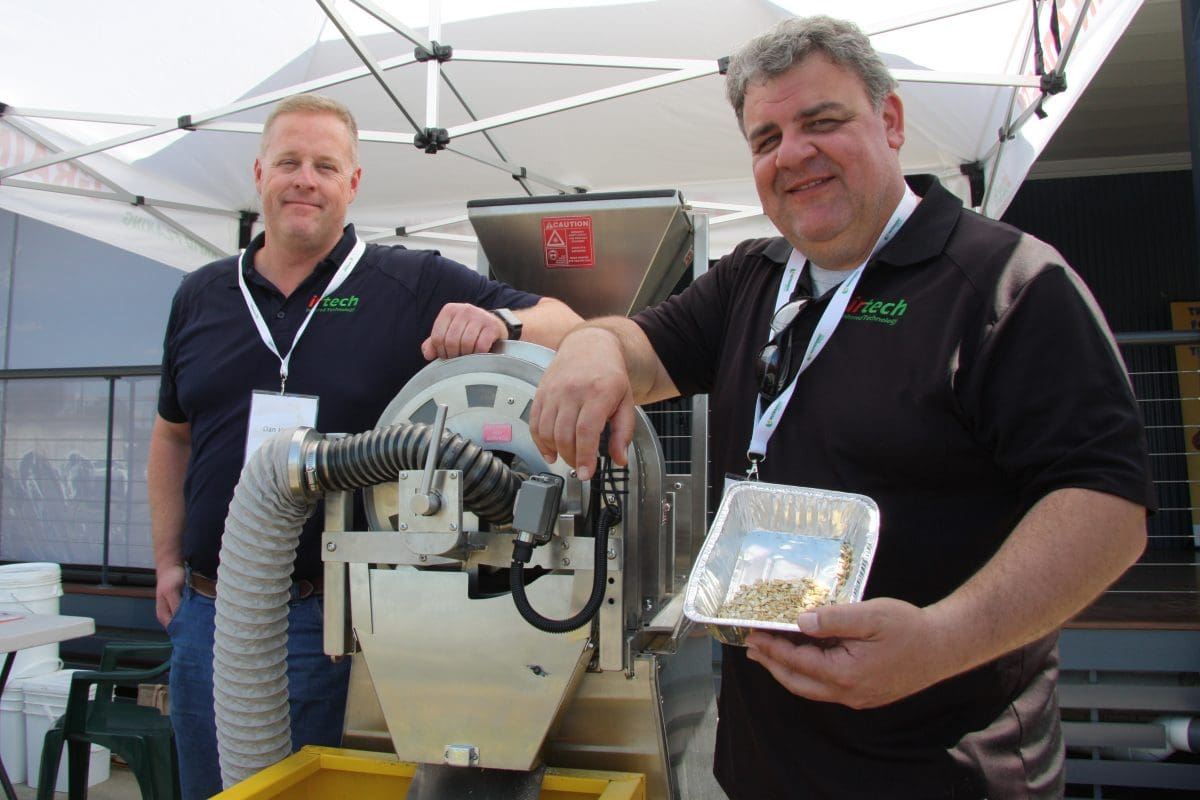
IRtech’s Dan Hawkins and Andrew Karagiannis exhibiting their GRAIN EDGE devitalisation and flaking process at the ALFA conference at Dalby last year.
A REPORT commissioned by volume feedgrain users says a facility built within a port zone to treat imported grain could improve their ability to weather future droughts.
The Review of grain devitalisation methods report outlines opportunities for importing bulk grain and plant-based stockfeed to offset a supply shortfall or excessive cost pressures resulting from drought in Australia’s east-coast production regions.
Commissioned by Meat and Livestock Australia in consultation with the Australian Lot Feeders’ Association (ALFA), with support from Dairy Australia, Australian Pork Limited and the Chicken Meat Federation, the report was prepared by the Colere Group.
The interstate grain and fodder transshipment program which started in 2017 now appears to be in its closing months as seasons improve over much of eastern Australia, industry is now thinking about how it can best prepare for the next drought.
Key findings:
- The successful importation of bulk grain and plant-based stockfeed for the livestock industry is a process of risk management for best-practice of the eradication and sterilisation of grain pests, pathogens and weed seeds;
- An opportunity exists for a multi-product processing facility to be established in Australia and operated from within a seaport quarantine zone. To match the feed demands of the intensive livestock industries, the facility must be able to treat whole-grain when it is imported, at a capacity of 10,000 tonnes per day;
- The research outlines the cost and effectiveness of several grain-sterilisation techniques, and found that an irradiation-based heat treatment, plus fumigation with ethanedinitrile, has the ability to meet the needs of grain importation as stand-alone treatments.
ALFA response
ALFA chief executive officer Christian Mulders said increasing climate variability in Australia meant a Plan B was vital for grain and fodder security.
“The grain and logistics industry should be commended for how well they’ve serviced the intensive animal industries during the most recent drought,” Mr Mulders said.
“However, we need to have technologies, systems and protocols tested and in place, ready to be implemented to keep our livestock industries in business.
“That’s why we’re exploring options and technologies to facilitate the safe importation of grain while ensuring Australia’s biosecurity reputation is protected.”
Risk management required
Colere Group managing director Paul Meibusch said the review team investigated grain-treatment techniques and their capacity to meet Australian biosecurity requirements for foreign grain importation now and into the future.
“The principal challenge associated with importing bulk grain or plant-based stockfeed is the requirement to devitalise or sterilise the product in order to minimise any biosecurity risk associated with pests and pathogens,” Mr Meibusch said.
“Devitalisation treatments need to ensure that any grain or weed-seed material is rendered incapable of germinating, and that any insect pests and pathogens are killed or rendered non-viable.
“Importing bulk grain is considered to carry greater risks than plant-based stockfeed, as the latter has generally undergone processing and, as such, devitalisation.”
Mr Meibusch said risk also needed to be managed when grain was transferred from the importing vessel to the nearby treatment plant to ensure zero spillage.
“Post-treatment, including any devitalisation, bulk grain and plant-based stockfeed still need to be handled appropriately to avoid the possibility of additional contamination.”
Potential all-in-one treatment
Among the report’s key recommendations is that ALFA and MLA assess GRAIN EDGE technology as a potential all-in-one treatment for any and all grains coming into Australia.
Australian-based company IRtech is part of the UNE Smart Region Incubator, and developed the technology using infra-red light to pasteurise, devitalise or micronise grain.
The process involves gelatinising starch to increase its digestibility.
IRtech project manager Dan Hawkins said the company was looking at uses beyond treating imported grain.
These included devitalising pulses and grain for export to selected markets, and also for use on wheat in mouse-baiting programs.
“Treating imported grain for biosecurity reasons is just one aspect of the business,” Mr Hawkins said.
The report identified an opportunity for a multi-product processing facility to be established within a port quarantine zone that could take advantage of the Inland Rail line now being built to link Brisbane and Melbourne.
“GRAIN EDGE has the potential to address all specific importation requirements around devitalisation, disinfestation and sterilisation while also offering a potential value-add to grain in the form of improved digestibility,” Mr Meibusch said.
“For this technology to progress in the grain-importation space, there are several trials required to confirm its efficacy and allow it to be added to the ‘approved treatments’ list.”
“This would effectively take what was formerly a bulk-grain importation issue and turn it into a plant-based stockfeed ingredient issue.”
“The viability of such a facility would rely on having at least some of the capacity being utilised for more regular activities, such as the importation of whole soy, with the ability to expand when domestic supply conditions become tight.”
To meet import biosecurity requirements, the report said a combination of treatments and supply-chain management factors was critical at points and stages including product source, ultimate destination and in-transit management.
However, risk management feasibility alone did not account for the commercial viability of such an undertaking, which is largely determined by the grain or stockfeed price differential.
The other key consideration is the commercial case for any domestic treatment facility that historically has not been required more than a few months each decade.
Source: MLA

HAVE YOUR SAY